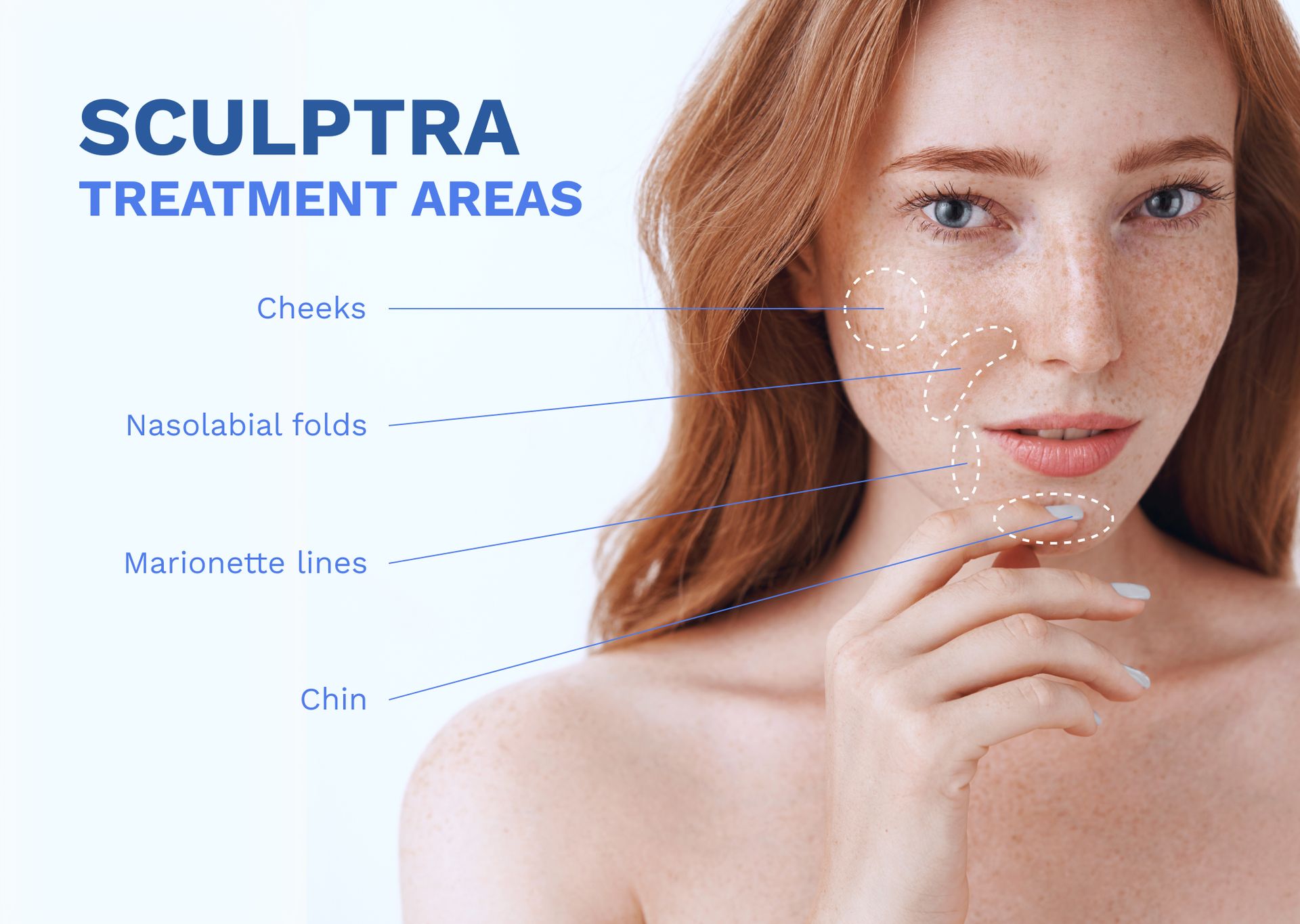As aesthetic medicine evolves, it's becoming more challenging to meet the diverse needs of patients – ensuring visible and long-lasting results without compromising on safety and convenience. With the rise of non-invasive facial rejuvenation, exploring new dermal filler brands becomes imperative. Among the best dermal filler brands, Sculptra stands out for its exceptional, long-lasting results. It addresses skin laxity and volume loss in key facial areas.
This article aims to evaluate the Sculptra pros and cons, providing a comprehensive overview of what Sculptra is, the areas and concerns it targets, its effects, and possible side effects.
What is Sculptra?
Sculptra is a Poly-L-lactic acid-based dermal filler that smoothes out wrinkles and skin sagging in the cheeks, jawline, and around the mouth. It works by stimulating collagen production, which tightens the skin and supports its structural integrity. The efficiency of Sculptra fillers is proved by several clinical studies. Patients' experience shows that 3 months after the treatment, the level of type 1 collagen increases by 65,5%. In about 90% of cases, patients have noticed improved skin tightness and glow for 2 years after the treatment.
Where is Sculptra injected?
Sculptra can be injected into different areas of the face, including cheeks, chin, around the mouth, and jaw. It targets marionette lines, nasolabial folds, and jawline, as well as contours the chin and cheeks.This versatility highlights what Sculptra is used for: targeting specific aging concerns across different facial areas to achieve a rejuvenated appearance.

How long does Sculptra last?
The effect of Sculptra fillers lasts up to 2 years. However, the exact duration depends on factors like treatment area, aftercare, individual characteristics, and treatment plan. Typically, long-lasting results require 2-3 sessions, 3-4 weeks apart. To extend the effect, you can learn more about dermal fillers' aftercare.
Is Sculptra safe? Are there any risks?
Sculptra is an FDA-approved (Food and Drug Administration) dermal filler. This means it's safe and effective for intended use. The incorporated Poly-L-lactic acid absorbs naturally in the body. The filler doesn't contain any harmful animal components. However, it's not recommended for patients with allergic reactions, history of keloid formation, hypertrophic scarring. Besides, pregnant and breastfeeding women under 18 cannot undergo the treatment. You should avoid using the filler in areas where skin sores, cysts, pimples, rashes, or hives.
Common side effects include:
- Bruising
- Swelling
- Pain
- Tenderness
- Itching
- Lumps
How does Sculptra work?
Sculptra is a bio-stimulating solution, so it works by stimulating collagen production. Collagen restores skin structure, attenuating wrinkles and folds, firming the skin, and reshaping the face. First, the specialist cleans the targeted area. Then, they apply numbing cream to minimize the pain during the treatment. After that, the specialist injects Sculptra filler. The microparticles of incorporated Poly-L-lactic acid penetrate the skin, stimulating collagen production. Collagen acts as a scaffold for the skin, reduces the appearance of wrinkles, and plums up the targeted area.
What should you do after Sculptra treatment?
After the treatment, you should massage the treated area to ensure even distribution and minimize the risk of lump development. Usually, patients see the results within a month after the procedure. Most patients report significant improvement in skin firmness, elasticity, and radiance for around 2 years after the Sculptra treatment. They can go back to their normal life after the treatment. However, they should avoid strenuous activities for a few days. They may experience swelling or bruising, but it will disappear after a few days. Discuss the importance of following the treatment course (usually 2-3 treatments) to ensure long-lasting results.
How much does Sculptra cost?
A pack of Sculptra dermal filler costs 310$ at ISLA-MED. Each pack contains two vials. However, the amount of vials required for a procedure depends on the injection area and desired results.
Buy Sculptra wholesale at a competitive price.
Conclusion
In conclusion, Sculptra is an effective and lasting solution for facial rejuvenation. It targets skin aging and volume loss issues in the cheeks, chin, around the nose, and mouth. Due to its Poly-L-lactic acid composition, it ensures an effect that lasts up to 2 years – longer than other fillers in the market. It works by stimulating collagen production, which not only smooths out wrinkles and adds volume but also enhances skin elasticity and firmness. While it may have some common side effects, Sculptra is considered safe as it's approved by the FDA (Food and Drug Administration). Moreover, its safety has been proven by various clinical studies. So, Sculptra is a reliable choice for aesthetic medicine specialists who seek quick and long-lasting solutions for facial rejuvenation.
FAQ
No, Sculptra is not permanent. While the effects of Sculptra can last up to 2 years, the filler is gradually absorbed by the body over time.
Yes, Sculptra can be combined with other cosmetic procedures, such as peeling, laser therapy, etc. However, it's essential to carefully evaluate each patient's individual needs and goals to determine the most suitable combination of treatments.
The downtime of Sculptra treatment is minimal. After a few hours, the patients can resume their everyday activities.
The safety of Sculptra treatments has not been proven for pregnant, breastfeeding, and lactating patients. The treatment is not recommended for patients with allergic reactions to filler ingredients.
